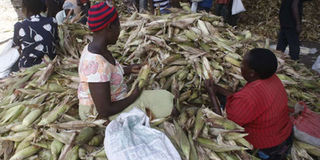Find ways to tame post-harvest food losses

Traders peel maize cobs at Wakulima Market in Nakuru County on February 28, 2018. A crucial but oft-ignored factor in reducing food losses is up-to-date reliable data. PHOTO | AYUB MUIYURO | NATION MEDIA GROUP
What you need to know:
- National and county governments need to collaborate with scientists to make such data available in a timely fashion.
- The capital intensity of storage facilities and the many agriculture-specific risks are two of the biggest challenges in access to financing.
An important workshop whose outcomes are critical to Kenya’s fragile food security situation went on almost unnoticed even as the Kenya Red Cross Society said 3.4 million hunger-stricken Kenyans needed assistance.
The workshop spearheaded by AgriProFocus, Socca, SIBKenya and SNV discussed techniques of reducing food losses to enhance profitability of agricultural enterprises and minimise food shortages.
A third of all food produced in the developing world is lost along the value chain, exposing businesses to unnecessary losses and putting populations at risk of hunger.
DATA
A crucial but oft-ignored factor in reducing food losses is up-to-date reliable data upon which proper decisions on food security can be made.
The key questions revolve around relevance, reliability and specificity of the data.
Lack of reliable data means policymakers will rely on guesswork to make decisions with far-reaching ramifications.
National and county governments, businesses and other stakeholders, therefore, need to collaborate with scientists to make such data available in a timely fashion.
Public-private partnerships have also played a role in enhancing food security and reducing food losses.
The public sector, primarily county governments, can partner with the private sector to create effective and efficient distribution channels and modern safe storage facilities.
It can also contribute to pro-PPP policy formulation.
STORAGE
It is difficult to talk about reducing post-harvest losses without delving into storage and storage facilities.
SNV, which has realised incredible success with its potato storage project for smallholder farmers in Meru, blames a fifth of food losses on poor distribution channels, 14 per cent on poor harvesting methods and 14 per cent on poor grading and storage.
Setting up a good storage facility is costly; they should be provided to farmers by counties at a reasonable fee or co-owned.
Ineffective and inefficient facilities eat into profits, cause food losses and lead to farmer- and market exploitation.
Agriculture employs 65 per cent of Africa’s population and makes up 32 per cent of its gross domestic product (GDP) but the sector receives less than one per cent of bank lending.
FINANCE
In the absence of accurate and cost-effective methods of assessing small-scale agricultural lending risk, financial institutions choose not to lend to the farmers, thereby contributing to the $450 billion global agriculture financing gap.
The capital intensity of storage facilities and the many agriculture-specific risks are two of the biggest challenges in access to financing.
But farmers also lack economies of scale due to the small-scale nature of many farming enterprises.
Herein, however, lies an opportunity: Farmers can engage in collective activity, which is more efficient and financially attractive, for instance, through cooperatives.
Banks and insurance firms can design financial products for the sector, especially the Bottom of the Pyramid Value Chain players.
LOANS
NGOs and other donors can encourage trade by de-risking through the banks instead of destabilising the market through direct donations.
Businesses also need to adopt sustainable and inclusive practices, which require them to be conscious of the three Ps — Profits, People and Planet.
Notably, how are we using land in food production?
Do we sell close to where we produce rather than transport food across the world?
Do we consume most, if not all, of what we produce to avoid putting pressure on Earth’s resources?
Ms Boomsma is coordinator, Sustainable Inclusive Business Kenya (SIBKenya). [email protected].





